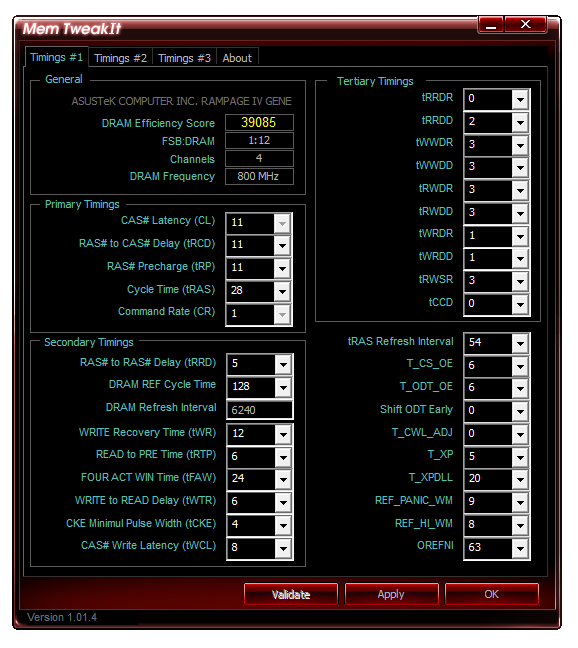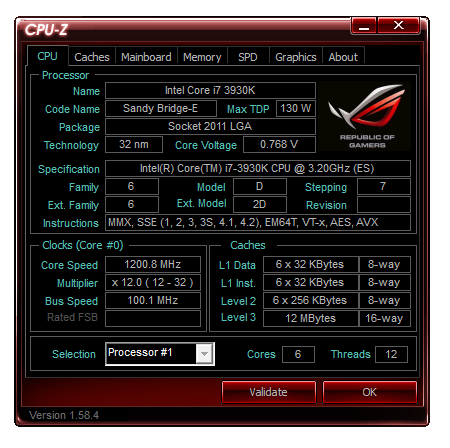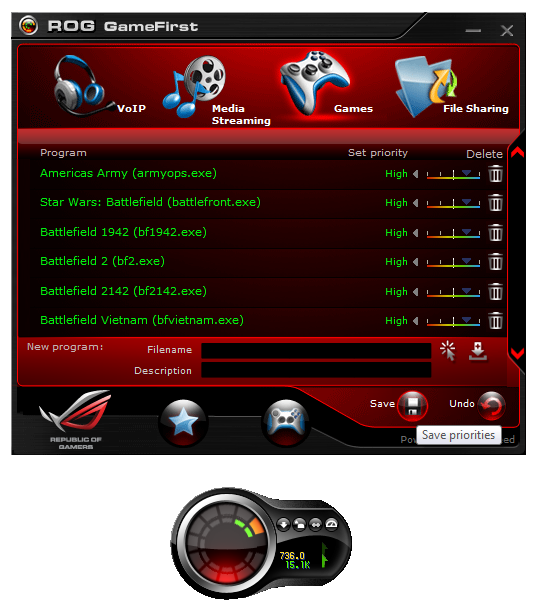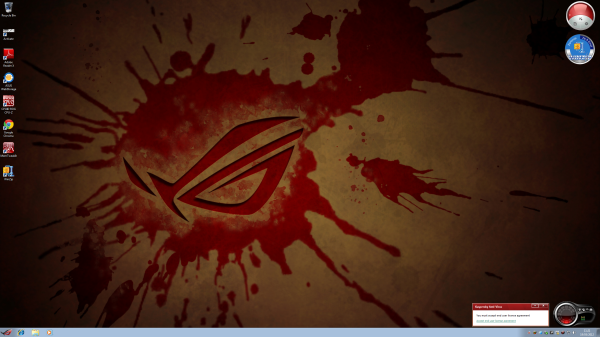ASUS Republic of Gamers and X79 ROG Review – Rampage IV Gene, Formula and Extreme
by Ian Cutress on August 3, 2012 1:00 PM EST- Posted in
- Motherboards
- Asus
- X79
- ROG
Hardware does not a product make. As all the parts of the motherboard come together, having a substantial software backbone should the user need it is vital. Software is used for managing the components, such as fans or overclocks, or monitoring and adjusting. In a similar ilk to their hardware, ASUS bundle a series of ROG labeled software products to retain a level of 'enthusiast focus' within the brand, alongside their standard software additions.
ROG MemTweakIt
For your competitive overclocker, it pays to be extreme in every part of the system - every edge you can get counts to the score. CPU speed is often the main priority, but if the benchmark requires fast memory, then that needs to be overclocked and tweaked as well. ASUS already do a good job BIOS side with memory options and compatibility, though having to go back to the BIOS each time to adjust the finer points of the memory can be a hassle. This is where MemTweakIt comes in.

I am no memory expert - I have repeatedly read Raja's write up on how memory works (http://www.anandtech.com/show/3851/everything-you-always-wanted-to-know-about-sdram-memory-but-were-afraid-to-ask) as I am sure some of you have, and came away needing to re-read it over and over again. Understanding the underlying reasons why memory works is important to a competitive overclockers score, helping them extract every drop of potential performance. However, I do not understand half of these options. ASUS provide them for the people that do, and for the users who want to tweak in the OS. Options such as the CAS Latency (CL) and Command Rate (CR) are decided at boot time and thus cannot be changed, but the rest can be. In order to aid those not au-fait with some of the options, ASUS add in a 'DRAM efficiency score' to provide a general 'all-purpose' usage synthetic for comparisons.
ROG CPU-Z
For system builders, testers, fixers and overclockers, the program CPU-Z is a very important tool. In 99.99% of cases, it will tell the user what the underlying system is, from the CPU to the motherboard and the memory - in the latest versions, also the GPU. This is very handy information to obtain without opening up the case or entering into the BIOS or various other programs. For competitive overclockers, it also provides as an official confirmation of the hardware being used, or as the basis for pure CPU-Z frequency validations.

The CPU-Z software itself is designed by CPUID, a company specializing in system monitoring, reporting and benchmarking. ASUS have done a deal with CPUID to provide a skinned version of CPU-Z for ROG formats in order to promote their branding. The ROG version of CPU-Z is a standard part of the software install, but is available for all through the CPUID website.
ROG GameFirst – Gene and Formula
As part of the ROG focus for gaming, namely the Gene and Formula more so than the Extreme, ASUS have bundled in network management software with these motherboards to help focus bandwidth.
It is common for gamers to have multiple programs running side by side while gaming - the application alongside a VoIP client, but also perhaps their mail client, messaging clients, or even in extreme cases, downloads. In a normal environment, each of these has equal footing - demand for bandwidth will be spliced between them all. In this case, the download would have the overall highest percentage of bandwidth, as it would be constantly requiring as much bandwidth as possible.
In order to mitigate this, ASUS have included GameFirst software.

The wheel at the bottom is the main image from GameFirst, showcasing whether the system is directly downloading or uploading content. Inside the options, a user can offer a pre-determined setting to give certain applications priority in the request stack - here we see games having priority. ASUS have many preset options for games, and users can add their own.
GameFirst is an interface of cFosSpeed, a software implementation of network management. Any user can purchase it on any motherboard, but ASUS have licensed it for their ROG products in the form of GameFirst.
Update: Game First II, the update version, is coming soon to the ROG range. This will be a free download to all users and will provide enhanced traffic shaping and network/service management.
ROG Bundled Software - Kaspersky Anti-Virus and Daemon Tools Pro
In talking with ASUS representatives, I quizzed them on the bundling of two software packages - Kaspersky Anti-Virus, and Daemon Tools Pro (a CD/DVD image mounting client). Both of these have associated BOM costs to add to the packages, and I was confused to the demand for these.
ASUS were very open with their reasoning. They found that a number of users were not running any anti-virus software at all, but when asked they said they would run some if it was good, was not intrusive on the gaming, and came free. Kaspersky is commonly rated as one of the best AV in the business, hence the inclusion to aid ASUS help their client base. I can see their reasoning - I would indeed use it above my current AV (which is also free and rates just behind Kaspersky). We should also note that Kaspersky has a special game mode to reduce memory and CPU usage.
The next bit of software, Daemon Tools, is something I have been using for the best part of 6 years with my backed up software. Rather than using a CD/DVD, I like to use a program to make an image of it, then call on that image to be 'mounted' on the system such that I can use the contents. I have been using the free version of Daemon Tools for this reason, and it seems that ASUS have determined that many other users do the same. As a result, they include Daemon Tools Pro as standard on their ROG motherboards.
ROG Windows7 Themes
A ROG system would not be a complete ROG unless there was a way to parade it over non-ROG users. ASUS include on their install DVD a set of ROG themes for Windows 7. These include a set of backgrounds (which in my experience work well at 2560x1440) for the desktop slideshow, as well as a change in the Start Menu, and mouse pointers.
ROG Exchange – The Future
The next part of the ROG branding for motherboards is the ROG Exchange. This feature, to be showcased initially on Ivy Bridge, is to help users of similar systems to share BIOS and OS settings and see how the professionals overclock.
This system is currently in closed beta, but the front facing part of the website is available to see: http://rog.asus.com/rog-pro/rog-exchange/.

















34 Comments
View All Comments
jontech - Friday, August 3, 2012 - link
But sounds kind of cool,.Helps that Asus makes it :)
Paulman - Friday, August 3, 2012 - link
Asus Republic of Gamers also holds Starcraft tournaments, as well! That's how I first heard of their brand. In fact, the ASUS ROG Starcraft II Summer 2012 tournament is on right now and I'm watching a game vs. EG.IdrA and EG.Puma (same team, but one American teammate versus a Korean teammate).For more info on this tourney, see: http://rog.asus.com/142982012/gaming/join-the-rog-...
primeval - Friday, August 3, 2012 - link
A fun tournament thus far.For the branding portion of this article, I highly recommend checking out some of ASUS ROG's commercials. They have been playing throughout the aforementioned tournament and I have to say they are probably the best hardware commercials I have ever seen in terms of production quality. I think that if you see a few of those commercials, you may be able to further rationalize the branding award.
Meaker10 - Friday, August 3, 2012 - link
1x/16x/8x/16x would kill any dual card setup in a micro atx case, kinda defeating the point....just4U - Friday, August 3, 2012 - link
the 8x slot is rather pointless...danjw - Friday, August 3, 2012 - link
I would rather see an article on the Ivybridge ROG motherboards then the Sandybridge-E ones. These are very niche boards, though I guess that is only slightly less true of the Ivybridge boards. For heavily threaded and memory intensive applications Sandybridge-E will win. But not really on much else, though they are chosen by some just because they are the most expensive.StevoLincolnite - Friday, August 3, 2012 - link
Also, Sandy Bridge overclocks higher and throws out less heat, because of the silly design choice that Intel made in regards to the heat spreader compound.Not a problem for those who are up to the task of removing the IHS or lapping.
Sad part is that Ivy Bridge actually has nice thermals and power consumption at stock; which could have translated well for enthusiasts.
IvyBridge-E should be out within the next year, haswell will get released and the cycle shall continue.
Hopefully we get 8 core Ivybridge-E chips, which is severely lacking on the Socket 2011 platform with the 3930K's being die harvested 8 core chips, plus most socket 2011 motherboards will take an Ivybridge-e chip anyway, when they're released.
danjw - Friday, August 3, 2012 - link
I was just looking at "leaked" slide that shows Ivy Bridge-E out in Q3 2013 and Haswell out in Q2 2013. I really don't see what the point is of an Ivy Bridge-E if Haswell beats it to the market. With Sandy Bridge-E they released it before the Ivy Bridge tock. I just don't see why that would make much sense.Assimilator87 - Saturday, August 4, 2012 - link
Haswell will probably be limited to four cores, whereas Ivy Bridge-E will scale up to ten cores.mapesdhs - Wednesday, May 9, 2018 - link
I was hunting for R4E refs and found this. It's strange reading what people expected was going to happen back when the R4E was new. IB-E with 10 cores eh? Oh well. Mind you, that did happen with IB-EP, and infact the XEON E5-2680 v2 is one of the best upgrades one can do for an X79 mbd, at least for threaded performance anyway. Hard to avoid wondering how things would have panned out if the 3930K had simply been a fully functional 8-core in the first place, instead of the crippled sampled chip consumers were offered. However, I obtained quite a few, and they still work pretty well, especially with so many PCIe lanes to play with, and it's cool being able to use a 950 Pro to boot from NVMe (comes with its own boot ROM), though the ROG forum does have a thread with custom BIOS profiles available to add native NVMe boot support to various ASUS mbds.